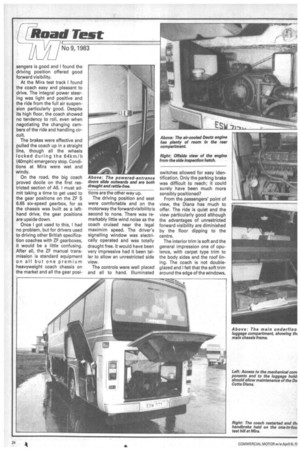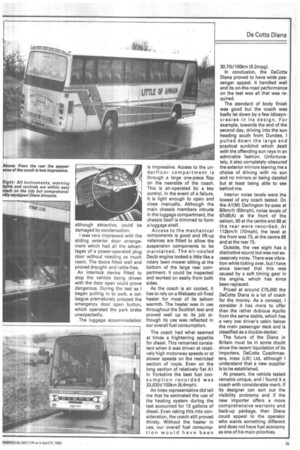A flawed beauty.
Page 25

Page 26

Page 27

If you've noticed an error in this article please click here to report it so we can fix it.
Visibility problems and a voracious appetite make Diana a demanding mistress, but there's reward in the easeful comfort. Noel Millier assesses her charms
1E OF THE most unusual aches launched onto the alicly highly competitive British ach markgt at the Birmingham )tor Coach was the DeCotta ma.
rhis is really a Magirus Deutz assis fitted with a Spanish lit Ayats high-floor coach dy. The fact that the coach is initially offered only on Maus Deutz chassis does not incase its attractiveness for tish operators, as the chassis not one normally imported o this country. In fact, the assis used was originally built left-hand-drive form and nverted to right-hand drive in As the chassis is not normally offered in Britain, the warranty attached to it is somewhat Iveco has said it will treat the vehicles as it does vehicles passing through the country. It does hold some spares and will do all it can to back the coach. The warranty is limited to the engine but the importer, Intex (UK), had arranged an insurance type warranty scheme to supplement this.
The Diana is undoubtedly eye-catching, with over twothirds of the front taken up with an enormous windscreen. From the sides I found the coach looked impressive although from the rear I have to admit I was somewhat disappointed in the proportions.
I found the standard of finish good, both inside and outside the body, but some of the design features were rather disturbing. For example, side visibility was restricted by unforgivable siting of the window line which directly obstructed one's vision. The large, heated, exterior mirrors were good but would have been even better if positioned to allow them to be used without the driver having to take his eyes from the road to look up into them. The saloon mirror was so high up I almost needed binoculars to see in to it.
The coach was fitted with 53 reclining seats, a sunken midmounted toilet and a driver's bunk. Access to the passenger deck is by four steps at the centre of the aisle behind the driving compartment or by six steps from the offside continental door. The view for the pas sengers is good and I found the driving position offered good forward visibility.
At the Mira test track I found the coach easy and pleasant to drive. The integral power steering was light and positive and the ride from the full air suspension particularly good. Despite its high floor, the coach showed no tendency to roll, even when negotiating the changing cambers of the ride and handling circuit.
The brakes were effective and pulled the coach up in a straight line, though all the wheels locked during the 64km/h (40mph) emergency stop. Conditions at Mira were wet and windy.
On the road, the big coach proved docile on the first restricted section of A5. I must admit taking a time to get used to the gear positions on the ZF S 6.65 six-speed gearbox, for as the chassis was built as a lefthand drive, the gear positions are upside down.
Once I got used to this, I had no problem, but for drivers used to driving other British specification coaches with ZF gearboxes, it would be a little confusing. After all, the ZF manual transmission is standard equipment on all but one premium heavyweight coach chassis on the market and all the gear posi tions are the other way up.
The driving position and seat were comfortable and on the motorway the forward visibilityis second to none. There was remarkably little wind noise as the coach cruised near the legal maximim speed. The driver's signalling window was electrically operated and was totally draught free. It would have been very impressive had it been taller to allow an unrestricted side view.
The controls were well placed and all to hand. Illuminated switches allowed for easy identification. Only the parking brake was difficult to reach; it could surely have been much more sensibly positioned?
From the passengers' point of view, the Diana has much to offer. The ride is quiet and the view particularly good although the advantages of unrestricted forward visibility are diminished by the floor dipping to the centre.
The interior trim is soft and the general impression one of opulence, with carpet type trim to the body sides and the roof lining. The coach is not doubleglazed and I felt that the soft trim around the edge of the windows, although attractive, could be damaged by condensation.
I was very impressed with the sliding exterior door arrangement which had all the advantages of a power-operated plug door without needing as much room. The doors fitted well and proved draughtand rattle-free.
An interlock device fitted to stop the vehicle being driven with the door open could prove dangerous. During the test as I began pulling in to park, a colleague prematurely pressed the emergency door open button, which operated the park brake unexpectedly.
The luggage accommodation is impressive. Access to the underfloor compartment is through a large one-piece flap on the nearside of the coach. This is air-operated by a key control. In the event of a failure, it is light enough to open and close manually. Although the main chassis members intrude in the luggage compartment, the chassis itself is trimmed to form a luggage shelf.
Access to the mechanical components is good and lift-up valances are fitted to allow the suspension components to be maintained. The air-cooled Deutz engine looked a little like a rotary lawn mower sitting at the bottom of the large rear compartment. It could be inspected and worked on easily from both sides.
As the coach is air cooled, it has to rely on a Webasto oil-fired heater for most of its saloon warmth. The heater was in use throughout the Scottish test and proved well up to its job although its use was reflected in our overall fuel consumption.
The coach had what seemed at times a frightening appetite for diesel. This remained consistent when it was driven at relatively high motorway speeds or at slower speeds on the restricted section of route. Even on the long section of relatively flat Al in Yorkshire the best fuel consumption recorded was 33.6314/100km (8.4mph).
An Intex representative did tell me that he estimated the use of the heating system during the test accounted for 13 gallons of diesel. Even taking this into consideration, the coach still proved thirsty. Without the heater in use, our overall fuel consumption would have been 30.71it/100km (9.2mpg).
In conclusion, the DeCotta Diana proved to have wide passenger appeal. It handled well and its on-the-road performance on the test was all that was required.
The standard of body finish was good but the coach was badly let down by a few idiosyncrasies in its design. For example, towards the end of the second day, driving into the sun heading south from Dundee, pulled down the large and ,practical sunblind which dealt with the offending sun rays in an admirable fashion. Unfortunately, it also completely obscured the exterior mirrors leaving me a choice of driving with no sun and no mirrors or being dazzled but at least being able to see behind me.
Interior noise levels were the lowest of any coach tested. On the A1(M) Darlington by-pass at 80km/h (50mph), noise levels of 67dB(A) at the front of the saloon, 65 at the centre and 68 at the rear were recorded. At 112km/h (70mph), the level at the front was 75, at the centre 68 and at the rear 75.
Outside, the vee eight has a distinctive sound but was not excessively noisy. There was vibration while ticking over, but I have since learned that this was caused by a soft timing gear in the engine, which has since been replaced.
Priced at around £75,000 the DeCotta Diana is a lot of coach for the money. As a concept, I consider it has more to offer than the rather dubious Apollo from the same stable, which has a very low driver's cabin below the main passenger deck and is classified as a double-decker.
The future of the Diana in Britain must be in some doubt since the recent liquidation of its importers, DeCotta Coachmasters, Intex (UK) Ltd, although I understand that a new supplier is to be established.
At present, the vehicle tested remains unique, and I found it a coach with considerable merit. If its designer can sort out the visibility problems and if the new importer offers a more comprehensive warranty and back-up package, then Diana could appeal to the operator who wants something different and does not have fuel economy as one of his main priorities.




































































































